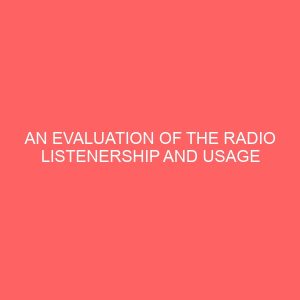Description
CHAPTER ONE
INTRODUCTION
1.1 BACKGROUND TO THE STUDY
In the recent years, fast developing technology has been fuelling an information revolution. The new media, digital broadcasting and the internet are sweeping away the limitations of the analogue world and weakening the grip of conventional platforms. The nature of the relationship between the broadcaster and its audience is changing. New media in this information age provides an immediate, informative, intelligent, interactive platform for discussion and debate.
Without mincing words, the latest trends in media technologies have changed the entire system of newspaper production The latest trends in media technologies have changed the entire system of newspaper production and circulation in Nigeria. Both the print and broadcast media are affected in one way or the other by the technology revolution (Kowet, 2000). Information is the primary input as well as the final output of Newspaper industry. It collects raw information and converts it into categorized, defined and useful pieces of information (McLuhan, 1994).
Therefore it will not be an exaggeration to say that the radical changes brought in the realm of Newspaper production and circulation through technologies (ICTs). Recent technology revolution in the media industry is bound to affect Newspaper more than any other industry. The adoption and absorption of media technology are being carried out in newspaper industry by bringing efficiencies in all the functional wings including newsgathering, production, editorial and marketing so as to gain competitive advantage (Indo American Print summit, 2008).
Media technologies are now used not just by press but increasingly by reporters and editors also in Nigeria. Its benefits are being recognized at every point of the entire supply chain of newspaper production (Harlan & Garry, 1999). The impact of media technologies on every aspect of Newspaper production, on the product, the production process, circulating, marketing and distribution in Nigeria cannot be overemphasized.
According to Chris (2001), technology development and absorption in Newspaper industry improved the printing process and reduced the operating time of editorial desks. The profuse use of online content and facilities has led to dominance of many-to-many model over one-to-many model of information collection. The individual or the department entrusted for the collection of information and news (Journalist) could gather information as per own and others convenience.
The wide range of editing, page making, database, photo imaging, and mixing software provided cutting-edge facilities to newspaper business which could now streamline and integrate intra-wings functions within a newspaper. The use of telefax, websites, online database, web-based information sites, and online readers and newsmakers, made the cumbersome job of information collection and reporting easier than ever before. The facilities of emails, personal blogs, and online discussion forums further have widened the canvas of information as the news of remotest areas could be retained within the headlines. Media technology made its presence felt in all quarters of news quarters.
It not only impacted the functioning of conventional newspapers and various departments but even gave birth to new avatar, the e-paper. Limitation of circulation of print versions, reach and accessibility, cost of newsprint abetted by unfathomable vista of Internet encouraged Conventional newspapers companies Nigeria to launch electronic version of editions. Thus, media technology made the newspaper available literally with a click of mouse anywhere anytime. However the e-paper is not a substitute to the print version rather a complement to the same. There is a complete transformation from the days when reporters used to file report, which had to be cleared and screened by band of sub-editors, followed by final checking of story by editor himself/herself and even an army of trained proof readers. Whereas now the reports are being filed online or on Local Area Network, read, crosschecked and edited electronically, saving time and money.
Media technology evolved because people from all walks of life needed help to understand the world around them (Kowet, 2000). Throughout history, conventional newspapers have excelled at collecting, recording, circulating and distributing information at many different levels and geographic locales. As they evolve in light of technological change, conventional newspapers need to embrace that mission anew. In fact, defining what is news is now more critical than ever. And it is their ability to do this within the context of new technologies that is the key to conventional newspapers’ survival.
Today, the use of advanced commercial printing machinery has also enabled newspaper industry to print copies with well-defined properties, capable of producing high precision graphic prints along with other direct mail printing services, the modern digital printing machines are printing 30 thousand and above copies per hour as against 3000 to 4000 copies per hour published by old printing press.
In the past, traditional conventional newspapers could only tell stories through text and images only, but now the advent of new media technologies allows journalists to tell stories in multiple channels. This increases the credibility of the story. It also allows users (readers), to become active participants in information creation. In other words, it turns users from been passive recipients of information to active participants of information production and circulation. This study is focused on The Nations newspaper which was launched in Lagos Nigeria on Monday July 31, 2006 and it is well circulated all over the nation.
The advent of New Communication Technology (NCT) has brought forth a set of opportunities and challenges for conventional media (Garrison, 1996). The presence of new media and the Internet in particular, has posed a challenge to conventional media, especially the printed newspaper (Domingo & Heinonen, 2008). Analysts in industrial organizations and businesses are of the view that the U.S. newspaper industry is suffering through what could be its worst financial crisis since the Great Depression (Barthelemy et al., 2011). Advertising revenues are tumbling due to the severe economic downturn, while readership habits are changing as consumers turn to the Internet for free news and information.
Some major newspaper chains are burdened by heavy debt loads. As in the past, major conventional newspapers have declared bankruptcy as several big city papers shut down, lay off reporters and editors, impose pay reductions, cut the size of the physical newspaper, or turn to Web-only publication (Kirchhoff, 2009). The new media have also affected the way conventional newspapers get and circulate their news. Since 1999, almost 90% of daily conventional newspapers in the United States have been actively using online technologies to search for articles and most of them also create their own news websites to reach new markets (Garrison, 2001).
In a similar note, Esimokha (2011) explains that, technological advancement has drastically altered the practice of journalism profession as never before. The emergence of computer and its application to newsgathering, writing, editing, design, production and distribution has changed previous approaches which were hitherto manual. The development of the internet and other Information and Communication Technologies (ICTs) innovations has transformed the print media industry significantly.
Nwabueze (2011:89) argues that, “a print media establishment in contemporary society can hardly survive without new communication technologies such as computers, the Internet, satellite television for monitoring local and international news, among others.” It is indeed on this note that this research work intends to evaluate the effect of the new media on the production and sales of a conventional newspaper in Nigeria. By virtue of this, the operations and survival of print media industry in terms of newsgathering and processing, including production and management of conventional newspapers and magazines shall be examined.
1.2 STATEMENT OF THE PROBLEM
Even though the advent of new media has enhanced the production of conventional newspapers in Nigeria in terms of newsgathering, processing, production and management of conventional newspapers, it has unarguably reduced its sales as most audience now prefer to use the new media platforms in accessing news and any other information. The rate at which people stay glued to social media today is quite alarming, a development that has drastically reduced the patronage of the conventional newspapers.
Without equivocation, it is now established that the ability of the new media to exert influence on the survival of the conventional newspaper is an unarguable reality hence the need to examine the level in which the presence of the new media has threatened the survival of conventional newspaper.
1.3 OBJECTIVES OF THE STUDY
To investigate the relationship between the new media and the conventional newspaper.
To investigate the area of divergence between the new media and the conventional newspaper
To investigate the positive effects of the new media on the operations of conventional newspaper
To investigate the negative effects of the new media on the operations of conventional newspaper
1.4 RESEARCH QUESTIONS
What is the relationship between the new media and the conventional newspaper?
What are the areas of divergence between the new media and the conventional newspaper?
What are the positive effects of the new media on the operations of conventional newspaper?
What are the negative effects of the new media on the operations of conventional newspaper?
1.5 RESEARCH HYPOTHESES
H1: There is a significant relationship between the new media and the conventional newspaper
H0: There is no significant relationship between the new media and the conventional newspaper
H2: There are areas of divergence between the new media and the conventional newspaper
H0: There are no areas of divergence between the new media and the conventional newspaper
H3: New media has positive effects on the conventional newspaper
H0: New media has no positive effects on the conventional newspaper
1.6 SIGNIFICANCE OF THE STUDY
The findings from this study will educate managers of newspaper industries and the general public on the effects of media technology on newspaper production and sales in Nigeria. It will also educate them on the effectiveness of the media technology and the problem associated with media technology with reference to newspaper production and circulation.
This research will be a contribution to the body of literature in the area of the effects of media technology on newspaper production and sales in Nigeria, thereby constituting the empirical literature for future research in the subject area.
1.7 SCOPE OF THE STUDY
In this case of carving out of this research, the study shall focus primarily on the effects of new media on the production and sales of conventional newspapers in Nigeria.
1.8 LIMITATION TO THE STUDY
Indeed, regrettably, the constraint encountered during the course of this research work revolves around the collection and analysis of data. Some respondents failed to return the questionnaire as at when required and some who returned failed to provide adequate response to some of the questions embedded in the questionnaire.
1.9 ASSUMPTIONS OF THE STUDY
The respondents will fully understand the questions being asked.
The instrument to be used will elicit reliable responses.
The respondents will provide honest expressions of their knowledge
The outcome of this study will be considered fit for generalization
1.10 DEFINITION OF TERMS
Conventional newspaper: A conventional newspaper can be best described as used in this study as conventional newspapers which are produced in a printed format to inform the general public about recent events, especially public affairs.
Newspaper production: This involves the process of gathering, editing, processing and printing of the contents of a newspaper.
New media: This can be said to be the means of mass comm unication using digital technologies such as the internet.








Reviews
There are no reviews yet.